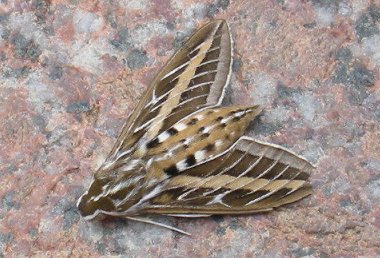Sphinx Moth larvae change underground
into adult moths, who then dig their way to the surface. Mating occurs
shortly thereafter, with females laying as many as 1,000 eggs on the
underside of food plants. Eggs hatch within a few days. In the Sonoran and Chihuahuan deserts, there may be 2 broods, one
in the Spring and another in the Summer. Males and females die after
they have completed their roles in the reproductive process.
days. In the Sonoran and Chihuahuan deserts, there may be 2 broods, one
in the Spring and another in the Summer. Males and females die after
they have completed their roles in the reproductive process.
|
The Sphinx Moth is also called
the Hawk Moth and the Hummingbird Moth because of its hovering,
swift flight patterns. |
Sphinx Moths emerge at dusk from their hiding places and begin feeding
on the nectar of flowers. Their size, combined with their rapid wing
beats, allow them to hover and feed like hummingbirds, for which they
are sometimes mistaken. This manner of flying requires a great deal of
energy. To meet its energy needs, the moth feeds exclusively on nectar
and seeks flowers which contain high amounts of sugar (like members of
the Primrose family, which the White-lined Sphinx Moth is responsible
for pollinating).
|

